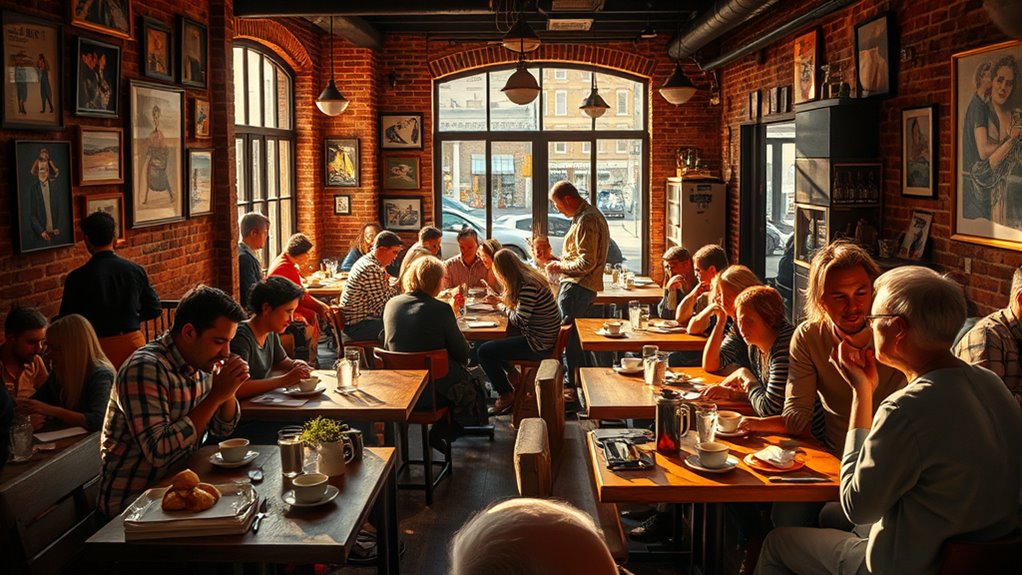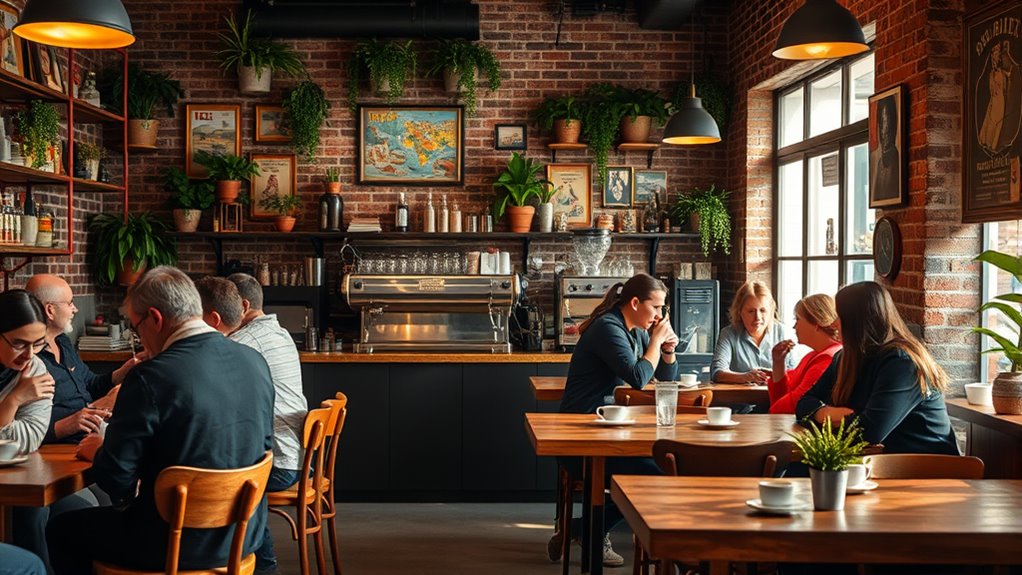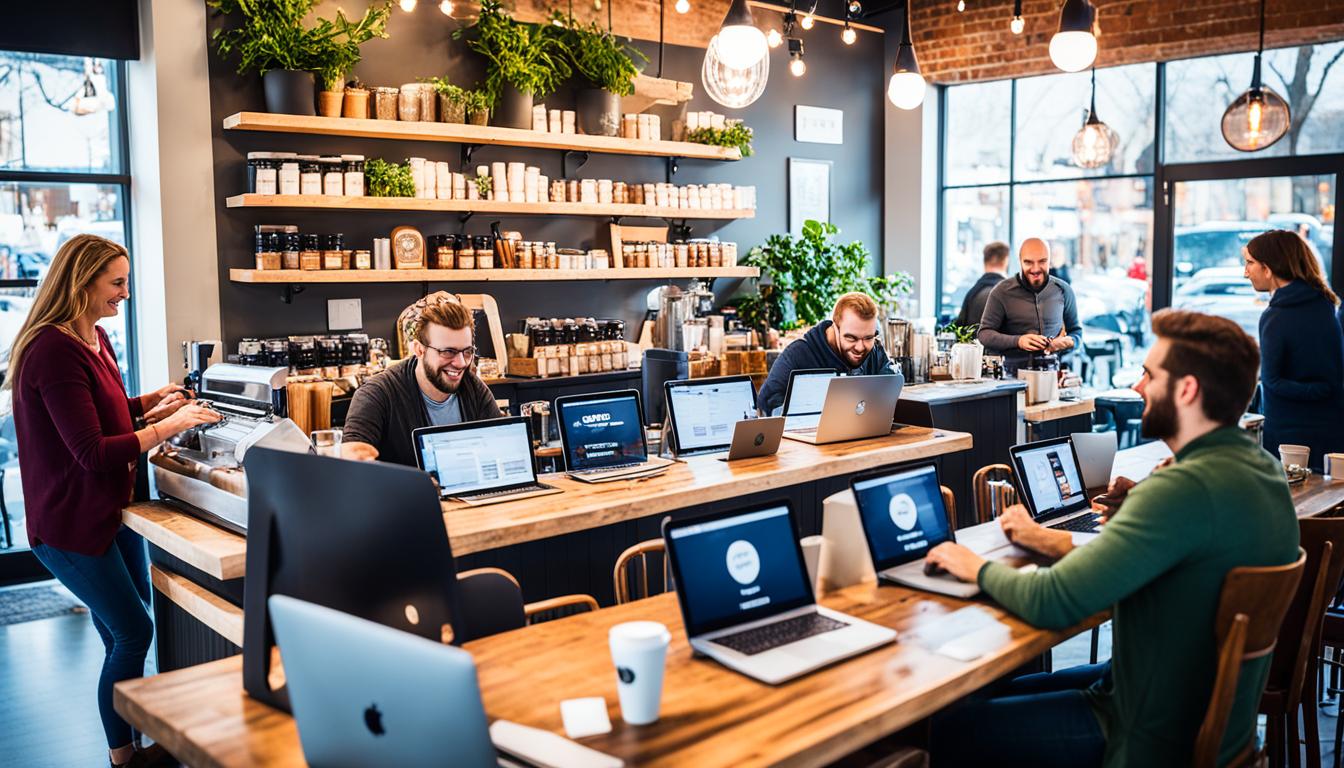Cafés have become social hubs by evolving into inviting spaces where you can connect with others and share experiences. They promote community bonding through conversations with baristas and neighbors, creating a sense of belonging. Unique atmospheres and diverse cultural offerings encourage interaction beyond just drinking coffee. Hosting events and activities further strengthen these connections. If you’re curious about how cafés continue to shape urban life and foster community, there’s more to discover ahead.
Key Takeaways
- Cafés foster community bonding by encouraging social interactions among patrons and creating a sense of belonging.
- Thoughtful design and ambient atmosphere promote engagement and facilitate conversations.
- They serve as cultural crossroads, showcasing diverse traditions and inspiring understanding through shared experiences.
- Hosting events like open mics and art exhibits transforms cafés into vibrant activity hubs.
- As urban social hubs, cafés contribute to community cohesion and enrich the city’s social fabric.

Have you ever wondered why cafés have become such essential social hubs? It’s because they serve as more than just places to grab a quick coffee; they’re spaces where community bonding flourishes and cultural exchange happens naturally. When you step into a café, you’re entering a setting that encourages interaction, whether it’s chatting with the barista, exchanging greetings with regulars, or sitting down with friends. These interactions create a sense of belonging, strengthening community ties, and making cafés crucial gathering spots in many neighborhoods. Over time, they become familiar environments where people from diverse backgrounds come together, sharing stories, ideas, and experiences. This environment of openness fosters community bonding, making cafés more than just commercial spaces—they’re social ecosystems. Additionally, cafés often utilize ambient lighting and layout design to promote a welcoming atmosphere conducive to conversation and connection.
Cafés foster community bonds and cultural exchange through everyday interactions and shared experiences.
Cafés also act as cultural crossroads, where cultural exchange is woven into the everyday fabric. You might notice how different people bring their own traditions into the space—ordering unique drinks, sharing local customs, or engaging in conversations about their origins. This blending of cultures enhances the café experience, making it a place for learning and appreciation. For instance, a traditional Turkish coffee served alongside a French croissant creates a mini cultural mosaic that sparks curiosity and dialogue. Cultural exchange in cafés isn’t limited to food and drink; it extends to music, language, and stories, allowing you to gain insights into others’ worlds without leaving your seat. Such exchanges foster understanding and break down stereotypes, transforming cafés into places where diversity is celebrated.
Furthermore, cafés often host community events—open mic nights, art exhibits, language meetups—that deepen these bonds and exchanges. These gatherings turn cafés into vibrant hubs of activity, inviting locals and visitors to participate actively. When you attend these events, you’re contributing to a sense of shared purpose and connection. It’s in these moments that cafés demonstrate their true role: as catalysts for community engagement and cultural dialogue. They’re spaces where every cup of coffee becomes an opportunity to meet someone new, learn something different, or simply enjoy the company of others.
In essence, cafés thrive because they’re more than just places to drink coffee—they’re social catalysts. They nurture community bonding and facilitate cultural exchange, making them essential parts of urban life. When you sit down in a café, you’re not just consuming a beverage; you’re becoming part of a broader social fabric that values connection, diversity, and shared experiences. That’s what truly makes cafés the social hubs we depend on today.
Frequently Asked Questions
You might wonder how cafés started as social spaces. Historically, cafés originated in the Middle East and Europe, evolving from places where people gathered to discuss ideas and share news. Their cultural evolution turned them into hubs of social interaction, fostering community and conversation. As you visit modern cafés, remember their roots in centuries of social exchange, reflecting a long tradition of people coming together to connect and exchange ideas over coffee.
You’ll find that Italian and French cultures have some of the most iconic café social traditions. Artistic cafés in Italy, like Venice’s historic spots, emphasize lively conversations and café etiquette that values leisurely chatting. In France, especially Paris, cafés serve as social hubs where people gather to debate, read, or simply enjoy each other’s company. These traditions highlight the importance of ambiance, art, and friendly interactions in fostering community.
How Do Modern Cafés Foster Community Beyond Serving Coffee?
Did you know that 65% of modern cafés host community events or art exhibitions? These activities help you connect with others beyond just grabbing coffee. By offering spaces for local artists or organizing events, cafés become vibrant social hubs. You can enjoy art shows or join discussions, making the café a place where community bonds grow stronger, turning your regular coffee stop into a lively gathering spot.
What Impact Do Cafés Have on Local Economies?
Cafés boost local economies by driving economic revitalization and supporting small businesses. When you visit these spots, you contribute to job creation and increased foot traffic that benefits nearby shops. Your patronage helps sustain local entrepreneurs and encourages neighborhood growth. By choosing to spend your money at community cafés, you actively support economic development, strengthening the local economy and fostering a vibrant, interconnected community.
Technology has transformed social interaction in cafés through digital communication and social media integration. You now often see people sharing moments online, connecting with friends virtually, or posting photos of their coffee. These innovations make interactions more dynamic, blending face-to-face conversations with digital exchanges. As a result, cafés become not just places to relax but also digital hubs, enhancing social engagement and expanding connections beyond physical boundaries.
Conclusion
Now, as you step back and reflect on how cafés transformed into social hubs, one question lingers: what’s next for these bustling spaces? Will they evolve further or face new challenges? The future of coffee and conversation remains uncertain, but one thing’s clear—you’re part of this ongoing story. So, next time you visit your favorite café, ask yourself: what role will it play in shaping tomorrow’s social landscape? The answer might surprise you.









